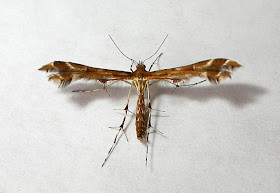On 25th June I was carrying out a daytime search for butterflies and moths along a public footpath close to the south-east corner of the Calvert land-fill site in Bucks and disturbed a very small tortricoid moth which I managed to net and then place in a pot to be looked at more closely when I got back home. Later that day, having photographed the moth and then studied the image, I could see that it was an Aethes species, possibly Aethes williana which I'd seen in that same general area previously, but it was rather too worn to be sure of the identity. I therefore retained the specimen in the freezer and it was eventually dissected by Peter Hall. Following a considerable amount of discussion between the experts it was eventually confirmed as a female Aethes margarotana, a moth previously known from coastal counties between Essex and Dorset and from the Channel Islands but which was now considered extinct. Contact with the various County Moth Recorders confirmed that the last known sighting on the UK mainland was at Felixstowe, Suffolk in July 1937.
Aethes margarotana
The second moth was a very small plume species caught in my Robinson MV trap during a session with Martin Albertini and Peter Hall on National Trust land at Bradenham, Bucks on 24th July. Not one that I was familiar with, it was potted and taken home to look at in daylight. The specimen was in good condition but even after photographing it I remained unsure as to what it was, the choice seemingly being between two rather similar moths (Oxyptilus parvidactylus and Capperia britanniodactylus). Again it was retained and eventually dissected by Peter Hall. This brought confirmation that the moth was in fact neither of the two species I'd considered but was actually an example of a male Oxyptilus pilosellae, which Colin Hart's recent book on the British Plume Moths states "has not been seen since the 1960s and may now be extinct". In fact the last known record would seem to be from the Beaconsfield area in 1964, so not all that far away from this discovery. DAVE WILTON
Oxyptilus pilosellae



No comments:
Post a Comment
Note: only a member of this blog may post a comment.